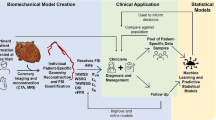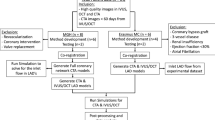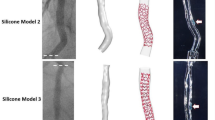Abstract
Computational fluid dynamics (CFD) can be used to model the blood flow in patient-specific arterial geometries and predict atherosclerotic plaque progression, as the site specificity of plaques has been shown to depend on the wall shear stress (WSS) experienced by an artery’s endothelial layer. The level of artery wall detail in CFD models is expected to underpin predictions of plaque deposition, as it influences the computation of WSS. In this study, the sensitivity of WSS computation to geometric variation in a (proximally) stented left anterior descending (LAD) coronary artery geometry is investigated. The geometry is reconstructed from intravascular optical coherence tomography (OCT) images, which are registered and merged with computed tomography (CT) to include surrounding arteries. The WSS is modelled for low-, medium- and high-resolution geometries; created by altering the point resolution of the contour algorithm used to trace the (OCT imaged) artery lumen. The results show that areas of low WSS (and thus high thrombotic susceptibility) in the stented portion of the artery depended greatly on the resolution of the geometric reconstruction. Compared with the high-resolution geometry, the low- and medium-resolutions failed to accurately determine the areas of low WSS in the stented region, as minor geometric features were inadequately represented. The sensitivity of WSS to geometric variation is also relevant to analyses using coronary artery geometries derived from other imaging modalities (particularly those of lower resolution than OCT).
Access this chapter
Tax calculation will be finalised at checkout
Purchases are for personal use only
Similar content being viewed by others
References
Murray C et al (2014) Global, regional, and national age-sex specific all-cause and cause-specific mortality for 240 causes of death, 1990–2013: a systematic analysis for the Global Burden of Disease Study 2013. Lancet 385(9963):117–171. doi:10.1016/S0140-6736(14)61682-2
Libby P, Ridker PM, Maseri A (2002) Inflammation and atherosclerosis. Circulation 105(9):1135–1143. doi:10.1161/hc0902.104353
Hansson GK (2005) Inflammation, atherosclerosis, and coronary artery disease. N. Engl. J. Med. 352(16):1685–1695. doi:10.1056/NEJMra043430
Caro CG, Fitz-Gerald JM, Schroter RC (1969) Arterial wall shear and distribution of early atheroma in man. Nature 223(5211):1159–1160
Friedman MH et al (1981) Correlation between intimal thickness and fluid shear in human arteries. Atherosclerosis 39(3):425–436
Cheng Z et al (2010) Analysis of flow patterns in a patient-specific aortic dissection model. J. Biomech. Eng. 132(5):051007. doi:10.1115/1.4000964
Kousera CA et al (2014) Patient-specific coronary stenoses can be modeled using a combination of OCT and flow velocities to accurately predict hyperemic pressure gradients. IEEE Trans. Biomed. Eng. 61(6):1902–1913. doi:10.1109/tbme.2014.2310954
Wellnhofer E, Goubergrits L, Kertzscher U, Affeld K (2006) In-vivo coronary flow profiling based on biplane angiograms: influence of geometric simplifications on the three-dimensional reconstruction and wall shear stress calculation. Biomed. Eng. Online 5:39–39. doi:10.1186/1475-925X-5-39
Toutouzas K et al (2015) Accurate and reproducible reconstruction of coronary arteries and endothelial shear stress calculation using 3D OCT: comparative study to 3D IVUS and 3D QCA. Atherosclerosis 240(2):510–519. doi:10.1016/j.atherosclerosis.2015.04.011
Stone PH et al (2012) Prediction of progression of coronary artery disease and clinical outcomes using vascular profiling of endothelial shear stress and arterial plaque characteristics: the PREDICTION Study. Circulation 126(2):172–181. doi:10.1161/circulationaha.112.096438
Ellwein LM et al (2011) Optical coherence tomography for patient-specific 3D artery reconstruction and evaluation of wall shear stress in a left circumflex coronary artery. Cardiovasc. Eng. Technol. 2(3):212–227. doi:10.1007/s13239-011-0047-5
Otake H et al (2009) Local determinants of thrombus formation following sirolimus-eluting stent implantation assessed by optical coherence tomography. J. Am. Coll. Cardiol. Intv. 2(5):459–466. doi:10.1016/j.jcin.2009.03.003
Slager CJ et al (2000) True 3-dimensional reconstruction of coronary arteries in patients by fusion of angiography and IVUS (ANGUS) and its quantitative validation. Circulation 102(5):511–516
Bourantas CV et al (2014) Fusion of optical coherence tomographic and angiographic data for more accurate evaluation of the endothelial shear stress patterns and neointimal distribution after bioresorbable scaffold implantation: comparison with intravascular ultrasound-derived reconstructions. Int J Cardiovasc Imaging 30(3):485–494. doi:10.1007/s10554-014-0374-3
Goubergrits L et al (2009) Coronary artery WSS profiling using a geometry reconstruction based on biplane angiography. Ann. Biomed. Eng. 37(4):682–691. doi:10.1007/s10439 -009-9656-7
Li Y et al (2015) Impact of side branch modeling on computation of endothelial shear stress in coronary artery disease: coronary tree reconstruction by fusion of 3D angiography and OCT. J. Am. Coll. Cardiol. 66(2):125–135. doi:10.1016/j.jacc.2015.05.008
J. Santos (2009) The influence of geometric factors on the wall shear stress distribution in realistic human coronary arteries. Dissertation, New University of Lisbon
Hetterich H et al (2015) Coronary computed tomography angiography based assessment of endothelial shear stress and its association with atherosclerotic plaque distribution in-vivo. PLoS One 10(1):e0115408. doi:10.1371/journal.pone.0115408
J.K. Hughey (2014) Computational evaluation of shear stress and restenosis in stented coronary arteries using optical coherence tomography. Master’s Thesis, Marquette University
Chenyang X, Prince JL (1998) Snakes, shapes, and gradient vector flow. IEEE Trans. Image Process. 7(3):359–369. doi:10.1109/83.661186
Tu S et al (2013) In vivo flow simulation at coronary bifurcation reconstructed by fusion of 3-dimensional X-ray angiography and optical coherence tomography. Circ Cardiovasc Interv 6(2):15–17. doi:10.1161/circinterventions.112.000051
Spiegel M et al (2011) Tetrahedral vs. polyhedral mesh size evaluation on flow velocity and wall shear stress for cerebral hemodynamic simulation. Comput Methods Biomech Biomed Engin 14(1):9–22. doi:10.1080/10255842.2010.518565
Roache PJ (1994) Perspective: a method for uniform reporting of grid refinement studies. J. Fluids Eng. 116(3):405–413. doi:10.1115/1.2910291
Doyle BJ, McGloughlin TM, Kavanagh EG, Hoskins PR (2014) From detection to rupture: a serial computational fluid dynamics case study of a rapidly expanding, patient-specific, ruptured abdominal aortic aneurysm. In: Doyle BJ, Miller K, Wittek A, Nielsen MFP (eds) Computational Biomechanics for Medicine: Fundamental Science and Patient-specific Applications. New York, Springer, pp 53–68
Leuprecht A, Perktold K (2001) Computer simulation of non-newtonian effects on blood flow in large arteries. Comput Methods Biomech Biomed Engin 4(2):149–163. doi:10.1080/10255840008908002
Biasetti J, Spazzini PG, Swedenborg J, Gasser TC (2012) An integrated fluid-chemical model toward modeling the formation of intra-luminal thrombus in abdominal aortic aneurysms. Front. Physiol. 3:266. doi:10.3389/fphys.2012.00266
Steinman DA et al (2013) Variability of computational fluid dynamics solutions for pressure and flow in a giant aneurysm: the ASME 2012 Summer Bioengineering Conference CFD Challenge. J. Biomech. Eng. 135(2):021016. doi:10.1115/1.4023382
Torii R et al (2009) Fluid–structure interaction analysis of a patient-specific right coronary artery with physiological velocity and pressure waveforms. Commun. Numer. Methods Eng. 25(5):565–580. doi:10.1002/cnm.1231
Myers JG et al (2001) Factors influencing blood flow patterns in the human right coronary artery. Ann. Biomed. Eng. 29(2):109–120
Boutsianis E et al (2004) Computational simulation of intracoronary flow based on real coronary geometry. Eur. J. Cardiothorac. Surg. 26(2):248–256. doi:10.1016/j.ejcts.2004.02.041
Dong J, Sun Z, Inthavong K, Tu J (2015) Fluid–structure interaction analysis of the left coronary artery with variable angulation. Computer methods in biomechanics and biomedical engineering 18(14):1500–1508. doi:10.1080/10255842.2014.921682
Taylor CA, Fonte TA, Min JK (2013) Computational fluid dynamics applied to cardiac computed tomography for noninvasive quantification of fractional flow reservescientific basis. J. Am. Coll. Cardiol. 61(22):2233–2241. doi:10.1016/j.jacc.2012.11.083
Kamiya A, Togawa T (1980) Adaptive regulation of wall shear stress to flow change in the canine carotid artery. Am. J. Phys. 239(1):H14–H21
Campbell IC et al (2012) Effect of inlet velocity profiles on patient-specific computational fluid dynamics simulations of the carotid bifurcation. J. Biomech. Eng. 134(5):051001–051001. doi:10.1115/1.4006681
LaDisa JF Jr et al (2005) Alterations in wall shear stress predict sites of neointimal hyperplasia after stent implantation in rabbit iliac arteries. Am. J. Physiol. Heart Circ. Physiol. 288(5):H2465–H2475. doi:10.1152/ajpheart.01107.2004
Joner M et al (2008) Endothelial cell recovery between comparator polymer-based drug-eluting stents. J. Am. Coll. Cardiol. 52(5):333–342. doi:10.1016/j.jacc.2008.04.030
Malek AM, Alper SL, Izumo S (1999) Hemodynamic shear stress and its role in atherosclerosis. JAMA 282(21):2035–2042
Lawrence MB, McIntire LV, Eskin SG (1987) Effect of flow on polymorphonuclear leukocyte/endothelial cell adhesion. Blood 70(5):1284–1290
Hardman D et al (2013) On the prediction of monocyte deposition in abdominal aortic aneurysms using computational fluid dynamics. Proc Inst Mech Eng H 227(10):1114–1124. doi:10.1177/0954411913494319
Author information
Authors and Affiliations
Corresponding author
Editor information
Editors and Affiliations
Rights and permissions
Copyright information
© 2017 Springer International Publishing AG
About this paper
Cite this paper
Kelsey, L.J., Schultz, C., Miller, K., Doyle, B.J. (2017). The Effects of Geometric Variation from OCT-Derived 3D Reconstructions on Wall Shear Stress in a Patient-Specific Coronary Artery. In: Wittek, A., Joldes, G., Nielsen, P., Doyle, B., Miller, K. (eds) Computational Biomechanics for Medicine. Springer, Cham. https://doi.org/10.1007/978-3-319-54481-6_1
Download citation
DOI: https://doi.org/10.1007/978-3-319-54481-6_1
Published:
Publisher Name: Springer, Cham
Print ISBN: 978-3-319-54480-9
Online ISBN: 978-3-319-54481-6
eBook Packages: EngineeringEngineering (R0)




